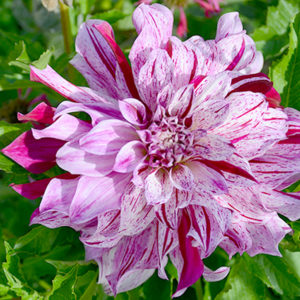Description
 Asiatic Garlic, Asian Tempest
Asiatic Garlic, Asian Tempest
GARLIC, which is a member of the same group of plants as the ONION, has been cultivated for millennia. As a cultivated plant, it is so old that it is difficult to credit a country of origin for this vegetable. Some historians believe that onions and garlic was indigenous to the southwest of Siberia and spread to southern Europe where it became naturalized. It is widely grown in all the Mediterranean countries.
All modern garlic belongs to one of two subspecies: hardneck (ophioscorodon) or softneck (sativum). Hardneck subspecies try to produce flower stalks with small aerial cloves called bulbils. Hardnecks will not produce large bulbs underground unless the flower stalks are removed. There are seven varieties of hardneck garlic: Asiatics, Purple Striped, Glazed Purple Stripe, Marbled Purple Stripe, Porcelain, Turban and Rocambole. Softnecks have lost the ability, for the most part, to produce a flower stalk. However, under certain climatic situations, the bulbs may try to produce a flower stalk known as bolting. There are four varieties of softneck garlic: Artichoke, Turban, Silverskin and Creole.
Asiatic garlics have not been known in the United States until the last 25 years. They were only grown by collectors and individuals with a sophisticated knowledge of garlic. However, in the past 25 years, the Asiatics have begun to rise in popularity and though they are still relatively hard to find commercially, they are available from some of the best garlic growing enterprises.
Along with the Rocamboles, the Asiatics, as a group, are some of the most flavorful garlics available today. They have some heat, but their general garlic flavor is rich and nutty.
The only negative about Asiatics concerns determining when to harvest. Unlike all the other garlic groups, the Asiatics mature rapidly and if not harvested early in the summer, they quickly lose their bulb skins and thus their storage capability.
The Asiatics should be harvested as soon as their first leaf begins to turn. It is critical that harvesting occur early, sometimes a month earlier than the other garlic cultivars.
Asiatic bulbs are not very large. In general, they are, at best, medium-sized, but the cloves, for a medium-sized bulb, are very large and great to cook with. The cloves cluster around a central scape stem which makes them easy to remove.
One last delightful attribute of Asiatics is that they can be planted in late winter or early spring. For the procrastinating gardener, this is great news. To be able to plant such an amazing garlic in the spring is a huge benefit.









